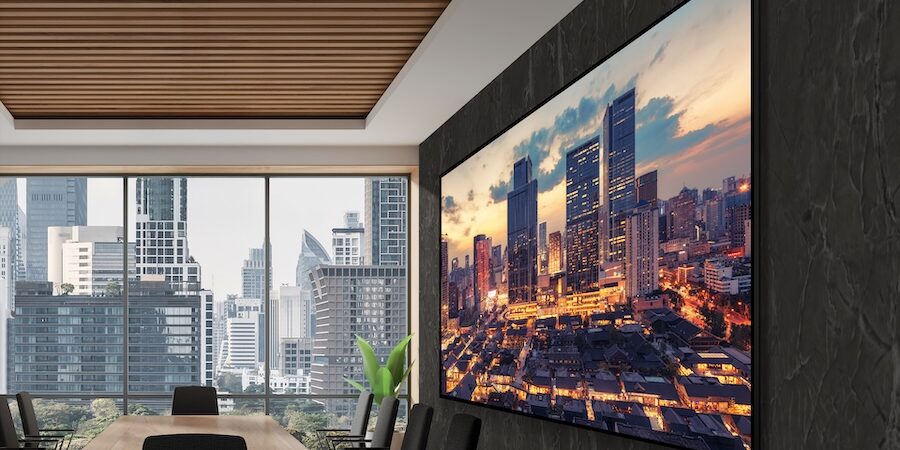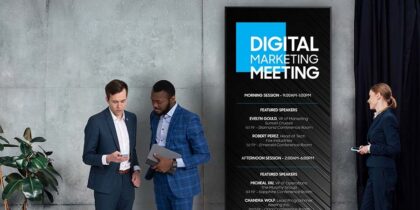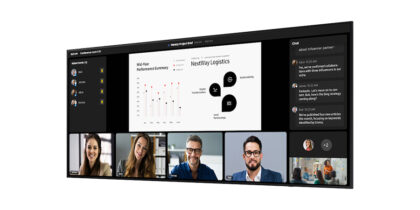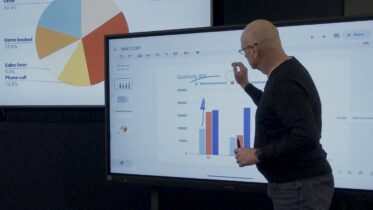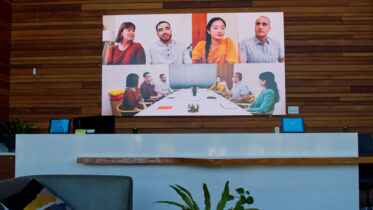Gensler, a global design and architecture firm, is helping to set the standard of the flexible modern office. Among the trends it sees for 2025 is the shift from desks to workpoints, noting that the approach helps create a collaborative and dynamic environment. The emphasis on collaboration, or “co-creation,” Gensler points out, requires an office design that supports interactive sessions and supercharges inclusivity.
That means flexibility, and companies across the board are following suit, too, as CBRE, the world’s largest commercial real estate services and investment company, highlights in a 2025 survey showing continued growth of flexible office spaces.
As a result, smart designers and consultants are seeking and selecting technology that supports this flexibility and fosters better collaboration. That’s because the right technology can play a critical role, especially when combined with these four strategies of office design for collaboration.
1. Outfit your space with technology to impress
However your office space is designed, technology is key to making it succeed. Outfitting collaboration spaces with the latest interactive displays, monitors and video conferencing tools is important to this, as it makes sure employees can accomplish whatever they need in the most efficient way possible.
Technology also has the power to transform even the smallest “huddle spaces” into collaboration hubs, whether it’s in subdivisions of a former large meeting room or a repurposed closet or storage area. With these technological tools, employees can organize quick, impromptu meetings, where they can connect on projects and brainstorm solutions without the formality and time commitment of a traditional meeting.
2. Bring wow to the table with stylish, functional technology
Often, it’s the idea of a drab, stodgy and uninspiring office that keeps employee affections — and location — at arm’s length, especially in a work world friendly to hybrid and remote environments. That’s why it’s essential for office designers to bring some wow to the table and create a work environment with pizzazz and personality.
How to plan and deploy direct view LED signage
Everything you need to know about choosing your LED displays for optimal viewing indoors and out. Download Now
It doesn’t need to be superfluous, either, as technology solutions can easily combine style and function. A great example is digital signage such as Samsung’s 115” Supersized Signage QH115FX 4K Commercial Display, which can employ top-of-the-line graphics and artwork to deliver information and wayfinding — especially with its ultra-large 115-inch screen that offers both landscape or portrait installation, 4K resolution and AI-powered upscaling. Despite its size, QH115FX features an impressively slim profile at just 1.3 inches. The refined depth enhances installation flexibility and elevates the overall aesthetic, making it perfect for modern environments where design matters as much as performance.
3. Build a collaboration nation
Every successful business knows that collaboration begets success. That’s why office designers are encouraging interactive displays, the best of which come with robust video conference capabilities — creating the ultimate collaboration experience. Installing interactive displays like Samsung WAF Interactive Display where collaboration happens helps make all presentations look their best and all attendees able to contribute easily.
Using Samsung WAF, for example, employees can work on documents and projects together, annotating the board with a finger or any input device, saving all content and sharing it via email. Samsung QH115FX supports collaboration, too, and can be ideal in a larger room with several attendees. The Smartview+ feature enables wireless screen sharing of up to nine devices, while the 60W 4.2.2 channel sound system brings every voice into the conversation loud and clear.
Effective collaboration also requires keeping an eye on the big picture. Samsung widescreen monitors like the ViewFinity S65VC Curved Monitor provide the means. On these screens, employees have enough space to keep multiple applications open at the same time, erasing the problem of missing out on the action happening on one while looking at another. The built-in cameras and speakers make hopping on quick calls with colleagues easy, encouraging more regular collaboration.
4. Provide seamless support
Collaboration works best in concert, with all oars pulling together. This requires a seamless system that ensures all parts are connected and operations are smooth across multiple platforms and devices. That goes for switching between remote, hybrid and office work, too. Just the time saved, alone, by seamless systems like Samsung’s quickly adds up to dozens of hours that can be rededicated to teamwork.
Samsung VXT, a cloud-based content management system, offers a significant boost to seamless operations. The platform unifies all the office’s digital signage into a central dashboard, where content can be created, scheduled and deployed, thanks to an extensive library of templates, imagery and logos. That provides employees with new ideas the tools to get them across with precision and polish.
Collaborate to success
A successful office is one that removes impediments to collaboration and provides platforms that enable it. Incorporating the most dynamic technology — digital signage, interactive whiteboards, widescreen monitors, powerful software — or interactive whiteboards with video conferencing capabilities — accomplishes both. The teamwork it inspires can also create an office culture more employees want to experience in person.
See the full range of Samsung display solutions to find the best fit for your office need, and learn more about the latest 115″ Supersized Signage QH115FX 4K Commercial Display.
